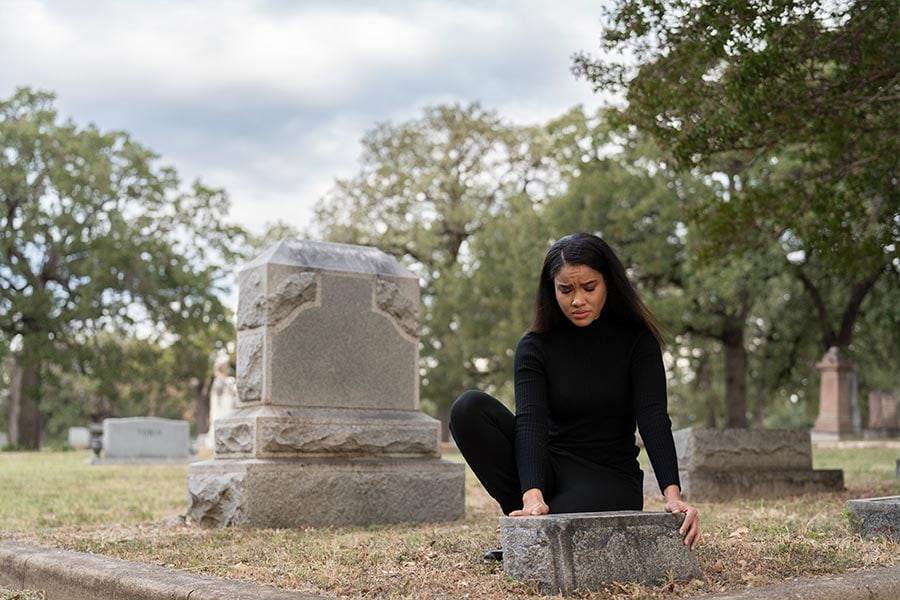Acts of remembrance

Praying for the faithful departed this November is a great way to speed a soul's journey from purgatory to heaven. (NTC/Juan Guajardo)
When the COVID-19 pandemic began to fully settle in around the spring of 2020, my outdoors-loving family and I had to look for other ways to experience time in nature. In the early stages of the lockdown, all Texas state parks were closed. This left us unfortunately unable to engage in our favorite way to refresh ourselves: a Saturday hike. Now unable to scratch this collective itch of ours by the usual method, we found ourselves searching for an alternative.
I can’t remember exactly when we got the idea to start visiting cemeteries. It was, in all likelihood, a suggestion of mine, as I had begun seriously delving into our family history, and cemeteries are by their nature some of our only links to those who came before us. It seemed to all of us to be a satisfactory substitute for our weekend hiking trips. After all, cemeteries are in fact outside, and there is usually at least a bit of walking involved in visiting them. Little did we know that what would begin as a substitute to sate our wanderlust during the lockdown would blossom into something much more.
All in all, grave hunting involves a lot more driving than walking. At least in Texas, and with a family both sides of which spring from mostly rural roots. Our map directions would, more often than not, take us down state and county roads none of us had ever been down before; we drove past farms, khaki-colored fields peppered with cows, and dilapidated old houses, the decaying remnants of lives come and gone.
Visiting these cemeteries stuck out in far-away corners, sometimes bearing the names of towns of which those interred used to be citizens, forces one to think about human transience: about how society ebbs and flows in response to a myriad of variables. It also underscores how our large cities are more and more acting like giant magnets, pulling people to themselves like iron filings.
Once we’d gotten out of the car and trudged through the cemetery gates, which were sometimes choked with weeds, the task of finding our sleeping kinfolk began. Up and down the rows of headstones we’d search, past other families, past lives tragically cut short by illness or maybe foul play. There were often rows composed only of souls who never remained in this world past childhood, their markers only shin high. To cover more ground, we usually split up, each of us combing a different quadrant. I imagine we looked not unlike a group of treasure hunters along a beach, only sans metal detectors; the treasure we were hunting was of a different, intangible sort.
“Found him!” or “Found her!” would then break the natural silence, calling the remaining two over to whichever one of us had found our mark. Strangely, first laying eyes on the headstone always touches a familiar area of the brain. It is not unlike the feeling of meeting a distant cousin you never knew you had; you’ve never seen this person before, but something about the outline of their face reassures you.
It is at this point that I have a desire to touch the headstone. It is as much a gesture commemorating a successful search as it is my way of saying to the soul which once animated the bones beneath my feet, “We’re still here. We haven’t forgotten you.”
I invite all of you reading this to think about who you are, and how you were born. None of us living today just popped into existence out of the ether, despite whatever delusions our rampantly individualistic culture may try and sell to us. We are all recombinations of our parents, and their parents before them, and on and on and on backwards through time. In a profound way, we are our ancestors, and they are us. Your fourth great-grandfather is, in a way, just as close to you as your father.
The Church has designated November as the Month of Holy Souls. Through the dual feasts of All Saints and All Souls we, as one body through the Church, remember and pray for all of those who have died in the faith. All Souls Day in particular is a vivid expression (and reminder) of the doctrine of purgatory: the place of final purification after death, where any remaining stain of venial sin left on the soul is purged away.
And while this teaching is at its core a merciful one — as a soul in purgatory is guaranteed a final place in heaven — the Church and Scripture also tell us that this process is far from pleasant. It is therefore a duty of those of us still on this side of the soil, the Church on Earth, to speed a soul’s journey through purgatory by means of our prayers for them. In order to do this, however, we must remember.
Apart from filling in gaps in the family tree, that is what our excursions to the graves of previously unknown family members have taught me: to remember. Any of the hundreds upon hundreds of our ancestors could, at this very moment, be in purgatory awaiting their final reward in heaven, in need of just one more person’s act of remembrance on their behalf.
For the rest of November (and indeed always), I encourage you to make a practice of this. Even if you don’t know the identities of the souls you pray for, pray for them nonetheless; your one prayer might be someone’s gateway to heaven. If you were in their place, wouldn’t you want there to still be at least one person who remembers?
